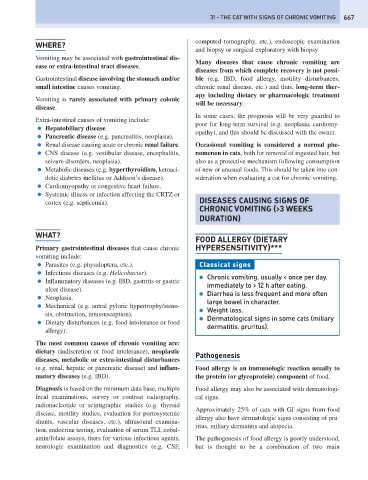Page 675 - Problem-Based Feline Medicine
P. 675
31 – THE CAT WITH SIGNS OF CHRONIC VOMITING 667
computed tomography, etc.), endoscopic examination
WHERE?
and biopsy or surgical exploratory with biopsy.
Vomiting may be associated with gastrointestinal dis-
Many diseases that cause chronic vomiting are
ease or extra-intestinal tract diseases.
diseases from which complete recovery is not possi-
Gastrointestinal disease involving the stomach and/or ble (e.g. IBD, food allergy, motility disturbances,
small intestine causes vomiting. chronic renal disease, etc.) and thus, long-term ther-
apy including dietary or pharmacologic treatment
Vomiting is rarely associated with primary colonic
will be necessary.
disease.
In some cases, the prognosis will be very guarded to
Extra-intestinal causes of vomiting include:
poor for long-term survival (e.g. neoplasia, cardiomy-
● Hepatobiliary disease.
opathy), and this should be discussed with the owner.
● Pancreatic disease (e.g. pancreatitis, neoplasia).
● Renal disease causing acute or chronic renal failure. Occasional vomiting is considered a normal phe-
● CNS disease (e.g. vestibular disease, encephalitis, nomenon in cats, both for removal of ingested hair, but
seizure disorders, neoplasia). also as a protective mechanism following consumption
● Metabolic diseases (e.g. hyperthyroidism, ketoaci- of new or unusual foods. This should be taken into con-
dotic diabetes mellitus or Addison’s disease). sideration when evaluating a cat for chronic vomiting.
● Cardiomyopathy or congestive heart failure.
● Systemic illness or infection affecting the CRTZ or
cortex (e.g. septicemia). DISEASES CAUSING SIGNS OF
CHRONIC VOMITING (>3 WEEKS
DURATION)
WHAT?
FOOD ALLERGY (DIETARY
Primary gastrointestinal diseases that cause chronic HYPERSENSITIVITY)***
vomiting include:
● Parasites (e.g. physaloptera, etc.). Classical signs
● Infectious diseases (e.g. Helicobacter).
● Chronic vomiting, usually < once per day,
● Inflammatory diseases (e.g. IBD, gastritis or gastric
immediately to > 12 h after eating.
ulcer disease).
● Diarrhea is less frequent and more often
● Neoplasia.
large bowel in character.
● Mechanical (e.g. antral pyloric hypertrophy/steno-
● Weight loss.
sis, obstruction, intussusception).
● Dermatological signs in some cats (miliary
● Dietary disturbances (e.g. food intolerance or food
dermatitis, pruritus).
allergy).
The most common causes of chronic vomiting are:
dietary (indiscretion or food intolerance), neoplastic
Pathogenesis
diseases, metabolic or extra-intestinal disturbances
(e.g. renal, hepatic or pancreatic disease) and inflam- Food allergy is an immunologic reaction usually to
matory diseases (e.g. IBD). the protein (or glycoprotein) component of food.
Diagnosis is based on the minimum data base, multiple Food allergy may also be associated with dermatologi-
fecal examinations, survey or contrast radiography, cal signs.
radionucleotide or scintigraphic studies (e.g. thyroid
Approximately 25% of cats with GI signs from food
disease, motility studies, evaluation for portosystemic
allergy also have dermatologic signs consisting of pru-
shunts, vascular diseases, etc.), ultrasound examina-
ritus, miliary dermatitis and alopecia.
tion, endocrine testing, evaluation of serum TLI, cobal-
amin/folate assays, titers for various infectious agents, The pathogenesis of food allergy is poorly understood,
neurologic examination and diagnostics (e.g. CSF, but is thought to be a combination of two main

